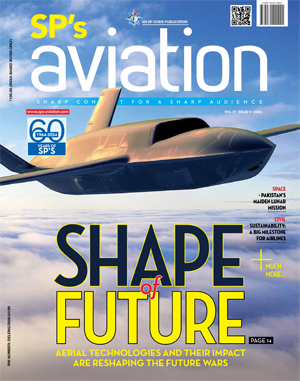INDIAN ARMED FORCES CHIEFS ON
OUR RELENTLESS AND FOCUSED PUBLISHING EFFORTS

SP Guide Publications puts forth a well compiled articulation of issues, pursuits and accomplishments of the Indian Army, over the years

I am confident that SP Guide Publications would continue to inform, inspire and influence.

My compliments to SP Guide Publications for informative and credible reportage on contemporary aerospace issues over the past six decades.
AEW&CS - IAF’s Eye in the Sky

With the induction of the Embraer 145 AEW&CS aircraft, the IAF has indeed embarked on a new journey. This, when fully operational, will undoubtedly introduce a unique dimension in the air defence capability of the IAF.
The first fully modified Brazilian Embraer 145 aircraft landed at HAL Airport at Bangalore on the night of August 22, 2012. This platform will now be integrated with a mission system developed by various laboratories of the Indian Defence Research and Development Organisation (DRDO) to serve as airborne early warning and control system (AEW&CS) for the Indian Air Force (IAF). This was the first of the three aircraft contracted in 2008 for $210 million ( Rs. 1,155 crore). The second aircraft is expected to arrive in December this year. The decision to place follow-on orders for three more aircraft may be taken based on operational experience.
Under the contract, Embraer will be the overall system integrator, mounting the 1.6-tonne radar and electronics on to the airframe ensuring that the aircraft retains the stipulated flight performance and is fit for recertification. Several laboratories of the DRDO are involved in the project. The Centre for Airborne Systems (CABS) is responsible for the overall integration of the aircraft’s electronic systems, mission computer, display and data handling. The Defence Electronics Application Laboratory (DEAL) will be responsible for the primary sensors, communication systems and data link. Defence Avionics Research Establishment (DARE) will provide a comprehensive self-protection system, electronic warfare suites and communication systems. The Defence Electronics Research Laboratory (DERL) will be involved with “counter-support measures”. Developmental test flight will be carried out in India beginning 2013 and may take a year or so.
Special Features
The twin-engine Embraer 145 jet will be equipped with indigenously developed active electronically scanned array (AESA) radar that has a fixed dorsal antenna where the required target area is scanned with the help of high speed electronic beam. This system is clearly better that the conventional rotating antenna as it has fewer moving parts. Besides, modern generation electronics are lighter and more capable.
The AESA radar has a detection range of 350 km, a 260-degree coverage in azimuth and can track more than 500 targets simultaneously. While the primary radar mounted on the aircraft is the AESA, the secondary surveillance sensor is the identification friend or foe (IFF) system. The AEW&CS will also have electronic support measures (ESM) and communications support measures (CSM) ability. Data links to network the AEW&CS with more than 40 other aircraft and ground-based control systems will also be provided as also satellite communication system (SATCOM). The avionics suite will be linked via a data handling system and will be controlled by mission computers. The self-protection suite (SPS) will have a passive missile approach warning system, a radar warning receiver and countermeasures dispensers. The SPS will be integrated with the ESM & CSM suites.
The Embraer 145 AEW&C aircraft features upgraded capabilities such as in-flight refuelling system for increased endurance, significantly enhanced electrical power generation and better cooling capacity. The airframe has undergone a comprehensive set of structural changes which will facilitate the installation of a wide range of advanced mission systems that have been developed by the various laboratories of the DRDO.
A True Force Multiplier
As a member of Embraer’s ISR family of aircraft and systems, the Embraer 145 AEW&CS platform can prove to be a true force-multiplier covering a range of operational missions related to intelligence, surveillance and reconnaissance (ISR) missions. These could include airspace management, directing own air defence fighter aircraft against intruding enemy aircraft and controlling interception by own aircraft, signals intelligence, surveillance of maritime boundaries as well as of exclusive economic zones (EEZ) and surveillance of land borders. However, in the Indian context, to begin with, the Embraer 145 AEW&CS aircraft will form a part of the air defence system.
The IAF currently operates a fleet of three IL 76 aircraft based Phalcon airborne warning and control systems (AWACS) as a primary component of the air defence system for early detection of intruding enemy aircraft and activation of the air defence weapons. With aerial refuelling capability, the AWACS aircraft of the IAF are able to fly missions of 14 hours or more at high altitude, extending surveillance coverage over large airspace well beyond the national boundaries. However, despite the elaborate ground-based air defence radar network, the few aerostats recently inducted and the limitations in the number of AWACS aircraft that are available to be kept on station, given the extent of land borders against the two not so friendly neighbours, there persists large gaps especially in low level radar cover on account of which the early warning available in respect of intruding enemy aircraft, is not adequate. With their large detection range, the AEW&CS platform could be used to complement ground-based early warning radars significantly enhancing capability of early detection. Operations of the AEW&CS will be integrated and other ground-based radars including aerostats, thus closing the existing gap in cover between ground-based air defence radars and the AWACS.





